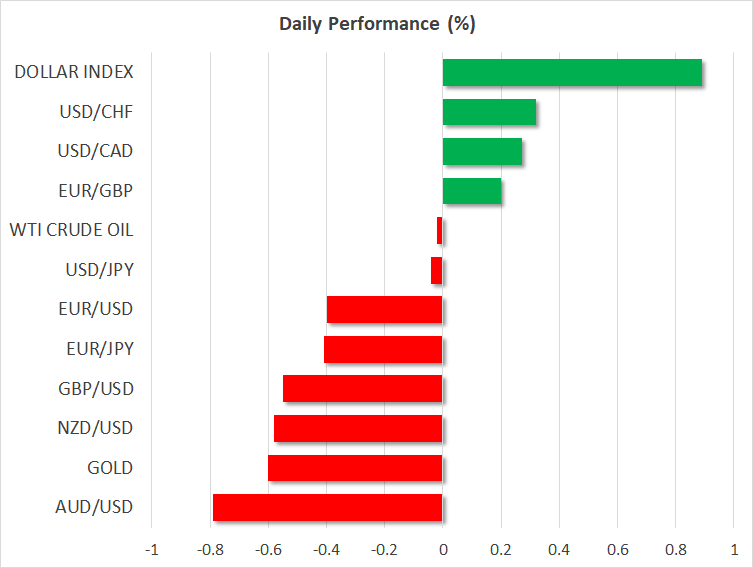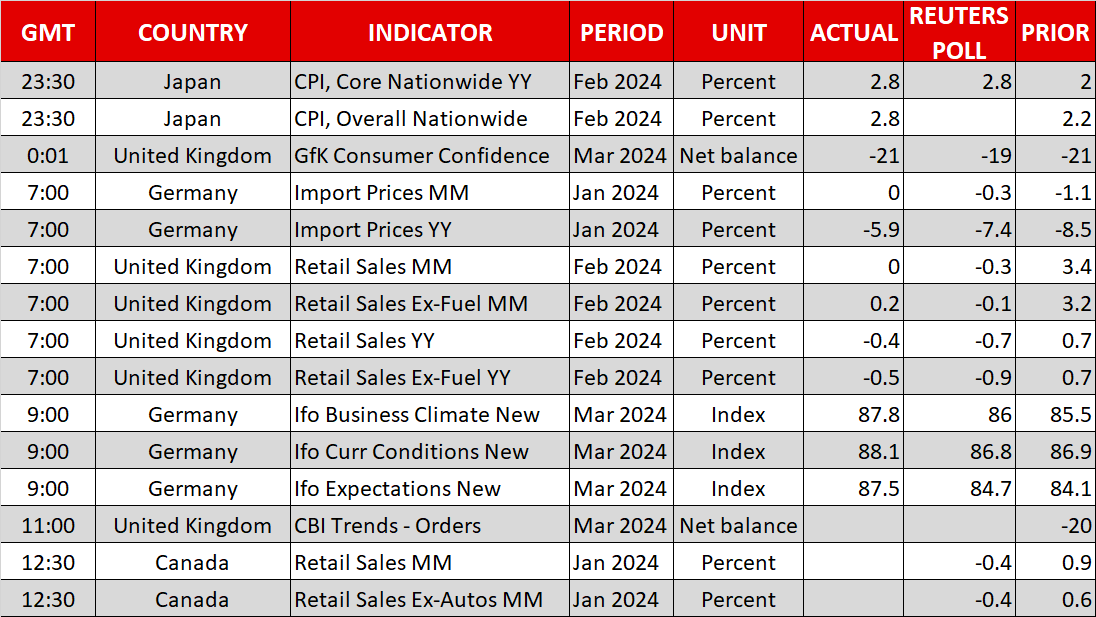- Wall Street leads rally in equity markets, fuelled by rate cut optimism
- But US dollar stages surprise rebound amid US exceptionalism
- Pound slides on BoE’s dovish tilt, yen steadies, PBOC loosens grip on yuan

Equities buoyed as easing expectations gather pace
Shares on Wall Street are headed for strong weekly gains following the conclusion of the March central bank meetings that cemented rate cut expectations for 2024. After the European Central Bank paved the way for lower rates at the beginning of the month, the Federal Reserve and Bank of England became the latest this week to not push back on market bets for a series of rate reductions later this year.
The Swiss National Bank went a step further and announced a surprise 25-basis-point cut, becoming the first major central bank to commence with an easing cycle, and even the Bank of Japan’s much-anticipated exit from negative rates turned out to be a dovish hike.
Whilst there’s still some uncertainty around the precise timing and scale of policy easing by the likes of the Fed and ECB amid ongoing stickiness in inflation, markets were relieved that the March policy decisions did not repeat the more hawkish tone of the January meetings.
Not that that stopped Wall Street from rallying, but with summer rate cuts now becoming somewhat more certain and a further recovery in bond yields looking unlikely, policymakers have provided fresh impetus to the bull market.
The S&P 500 closed at a new all-time high for the third straight session on Thursday, taking its weekly gains to 2.4%, while the Nasdaq Composite finished above 16,400 for the first time. French and German indices also notched up record highs, London’s FTSE 100 played catchup, while the Nikkei 225 extended its post-BoJ gains today to close at yet another all-time peak.
Yuan plunges, aussie underperforms
The mood wasn’t so cheery in China and Hong Kong where stocks slid on renewed efforts by US lawmakers in the House of Representatives to restrict investments by US mutual funds in certain Chinese entities. Regional markets were also unnerved by signs that the People’s Bank of China is loosening its grip on the yuan after it set a lower midpoint, triggering a tumble to just below the 7.23 per dollar level – the weakest in four months.
Expectations for further policy easing in China have been weighing on the yuan for some time now but until now, authorities were reluctant to allow the currency to depreciate much as that tends to be interpreted as a sign that the economy is struggling.
Moreover, the timing coincides with a fresh surge in the US dollar as investors scale back their bets that the Fed will be more aggressive than other central banks in cutting rates.
The Australian dollar fell the most on Friday, more than reversing yesterday’s short-lived gains on the back of very strong domestic employment numbers. The Swiss franc has fallen to fresh four-month lows versus the greenback, the euro came close to breaching the $1.08 level earlier in the day, while sterling is ploughing one-month lows below $1.26.
BoE signals rate cuts likely, pound slips
The Bank of England kept interest rates unchanged as expected on Thursday, but Governor Andrew Bailey followed up the decision with an interview with the Financial Times, saying that rate cuts were “in play”. The pound had already come under pressure from the announcement itself that showed the last two remaining MPC members that had been voting for a hike decided not to dissent this time, in a notable dovish shift for the committee.
Bailey also appeared to endorse the markets’ view of more than one cut this year. It comes after UK inflation plummeted to 3.4% in February, with further declines expected in the coming months. Stronger-than-expected retail sales figures out of the UK today did little to stem the pound’s fall against the resurgent dollar.
Dollar whipsaws but yen steadier
The dollar has whipsawed this week, initially coming under pressure from a somewhat more dovish-than-anticipated Fed meeting, before reversing sharply higher. The first clue for another leg higher came on Tuesday after markets were unimpressed with the Bank of Japan’s tentative steps to fully exit from its stimulus policies, while the latest trigger came from the SNB’s unexpected cut on Thursday that took the shine away from the Fed.
It seems that although investors are optimistic about the prospect of three rate cuts by the Fed this year, yield spreads are unlikely to narrow much in favour of other currencies if their central banks are also slashing rates.
Crucially, there’s a greater risk of the Fed not matching the number of expected rate cuts than other central banks given the far superior state of the US economy. Yesterday’s upbeat jobless claims, housing numbers and PMI surveys underscored this view.
Hence, US exceptionalism may keep the dollar well bid for a while longer, giving currencies such as the yen little chance of a comeback. The yen’s slump prompted Japan’s Finance Minister Suzuko to warn earlier today that they are watching FX moves with “a high sense of urgency”, helping the Japanese currency to stabilize around 151.50 per dollar.
Gold, however, tumbled as the dollar jumped, easing to around $2,166/oz from yesterday’s record highs, while oil futures remained on the backfoot on hopes of a Gaza ceasefire agreement being close.
